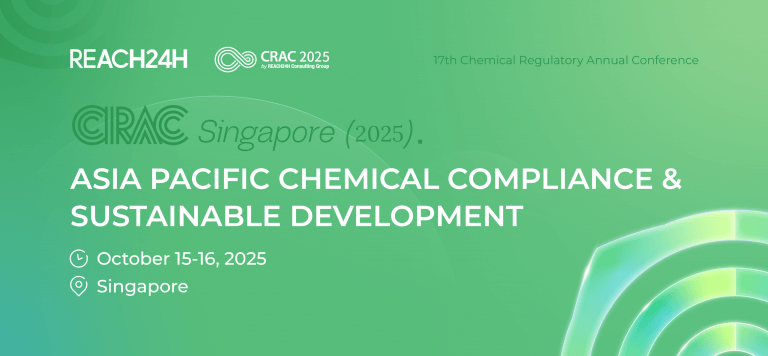Introduction
In January 2025, the Global Electronics Council (GEC) officially released the updated Reduction of Chemicals of Concern Criteria for EPEAT Registry. This latest standard strengthens chemical management requirements across the entire supply chain—from raw materials to manufacturing processes.
Key Updates in the 2025 EPEAT Registry Standards
REACH24H has summarized five key areas closely related to chemical raw materials under the new criteria:
1. Chemical Management in Products
| Detail | Requirement | Score |
| 1.1 Conformance with provisions of European Union RoHS Directive | Mandatory | - |
| 1.2 Conformance with substance restriction requirements of the European Union Battery Regulation | Mandatory | - |
| 1.3 Disclosure of substances listed in the SVHC Candidate List exceeding threshold levels | Mandatory | - |
| 1.4 Reduction of substances on the European Union REACH Regulation Candidate List of SVHCs for Authorization (< 0.1% per article by weight, excluding EU RoHS permissible uses) | - | 1 point |
| 1.5 Reduce bromine/chlorine in plastic components (≥25g: ≤1000 ppm or ≤5000 ppm for recycled materials) | Mandatory | - |
| 1.6 Further reduction of bromine/chlorine in plastic components (≥5g: ≤1000 ppm) | - | 1-2 points |
| 1.7 Reduce PFAS in plastic components (≥25g: fluorine ≤100 ppm or ≤5000 ppm for recycled materials) | - | 1 point |
| 1.8 Reduce beryllium content (≤1000 ppm) | - | 1 point |
| 1.9 Confirm material safety for long-term skin contact via risk assessment | - | 1 point |
2. Material Transparency and Substance Disclosure
| Detail | Requirement | Score |
| 2.1 Record of declarable substances (Manufacturer must record presence of IEC 62474 DSL substances/groups above reporting thresholds). | Mandatory | - |
| 2.2 Disclosure of declarable substances (Make the record from 6.2.1 publicly available on the website). | - | 1 point |
| 2.3 Requesting substance inventory (Manufacturer must request chemical substance information from suppliers for materials/components/parts comprising ≥ 80% of total product weight). | Mandatory | - |
| 2.4 Product manufacturers obtain chemical substance information for materials, components, and parts from suppliers | - | 1-2 points |
| 2.5 Product manufacturers obtain, document, and publicly disclose PFAS substance information for materials, components, and parts from suppliers | - | 1-2 points |
3. Hazard Assessment and Public Disclosure
| Detail | Requirement | Score |
| 3.1 For plastic components ≥25g (≥10g for mobile phones) containing intentionally added flame retardants or plasticizers, manufacturers must use assessment methods (e.g., GreenScreen® or ChemFORWARD) to confirm the absence of high-hazard chemicals. | - | 1-3 points |
| 3.2 For PFAS substances in semiconductor etching solutions (fluorinated surfactants/lubricants), coatings, adhesives (fluorinated solvents), or rechargeable battery fluorinated materials, manufacturers must use assessment methods (e.g., GreenScreen® or ChemFORWARD) to confirm the absence of high-hazard chemicals. | - | 1-3 points |
| 3.3 Manufacturers may optionally publicly disclose assessment reports (e.g., GreenScreen® or ChemFORWARD) on their official website. | - | 1 point |
4. Process Chemicals in Manufacturing
| Detail | Requirement | Score |
| 4.1 Reduction of high-priority process chemicals during production, i.e., substances posing high hazards to workers or the environment that are already in use or suspected to be used in relevant manufacturing processes. | - | 1 point |
| 4.2 Producers shall annually collect information on the usage of process chemicals during production from 30 facilities in the product supply chain or at least 50% of total facilities (if total facilities are fewer than 60), including substance lists, suppliers, usage quantities, and worker involvement. | - | 1 point |
5. Reducing Chemicals of Concern in Packaging
| Detail | Requirement | Score |
| 5.1 No intentional addition of heavy metals in packaging; unintentional impurities ≤100 ppm (w/w). Elemental chlorine shall not be used as a bleaching agent for virgin or recycled fibers in paper-based packaging (unprocessed and/or recycled). Polyvinyl chloride (including polyvinylidene chloride) and phthalates listed in EU RoHS or EU REACH Annex XIV shall not be intentionally added. Total PVC concentration in packaging shall not exceed 100 ppm chlorine (w/w), and total phthalate concentration shall not exceed 100 ppm (w/w). | Mandatory | - |
| 5.2 No intentional addition of PFAS substances in packaging. Total fluorine concentration in packaging shall not exceed 100 ppm (w/w). | - | 1 point |
What Is the EPEAT Registry?
The Electronic Product Environmental Assessment Tool (EPEAT), developed by the Global Electronics Council (GEC) and supported by the U.S. Environmental Protection Agency (EPA), is a leading Type 1 eco-label launched in 2006. It evaluates the environmental impact of electronic products throughout their entire life cycle, empowering businesses and consumers to make more sustainable choices.
EPEAT Registry currently covers a wide range of technology products and services, including:
Computers and displays
Imaging equipment
Mobile phones
Photovoltaic modules and inverters
Televisions
In addition, EPEAT has introduced a new program called EPEAT Climate+, designed to highlight products that contribute to climate change mitigation through environmentally conscious design and manufacturing.
As of today, 40 leading electronics brands and more than 33,195 products in the Computer and Display category alone have achieved EPEAT Registry.
Why Staying Compliant Matters
Conformance with the 2025 EPEAT criteria significantly raises the bar for chemical management transparency, substance restrictions, and environmental disclosures. Companies involved in electronics manufacturing, chemical material supply, and packaging design must adapt quickly to remain competitive in global markets.
Early preparation not only ensures smoother registration and facilitates achieving higher EPEAT tiers (Silver/Gold) but also strengthens corporate sustainability profiles and enhances brand reputation.





